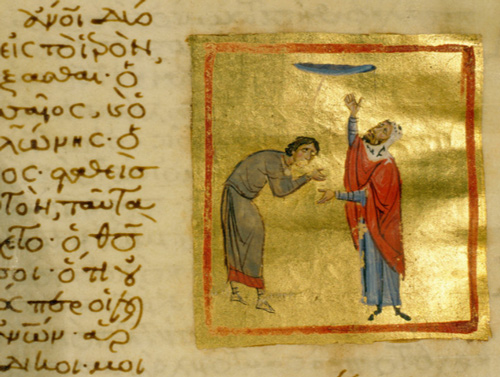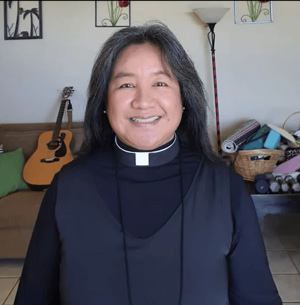
The designation of this day, Jan. 1 as Feast of the Holy Name is new to the 1979 revision of The Book of Common Prayer. Previous Anglican Prayer Books called it the Feast of the Circumcision. January 1 is the eighth day after Christmas Day, and Luke’s Gospel records that eight days after his birth the child was circumcised and given the name Jesus.
The liturgical commemoration of the circumcision probably originated in France. The Council of Tours in 567 enacted that the day was to be kept as a feast day to counteract pagan festivities connected with the beginning of the New Year.
The Feast of the Holy Name has been celebrated in the Roman Catholic Church (usually on January 1) since sometime in the 15th century. The Lutheran church also commemorates the Feast of the Holy Name on January 1.
The early preachers of the Gospel lay stress on the name as showing that Jesus was a man of flesh and blood, though also the son of God, who died a human death and was raised by God from death to be the Savior.
The name “Jesus” is from the Hebrew Joshua, or Yehoshuah, “Yahweh is salvation” or “Yahweh will save.” Devotion to the Holy Name of Jesus is particularly derived from Phil 2:9-11, which states that God highly exalted Jesus “and gave him the name that is above every name, so that at the name of Jesus every knee should bend, in heaven and on earth and under the earth.” This scriptural devotion is paraphrased by the hymn “At the name of Jesus” (Hymn 435) in The Hymnal 1982. Other hymns that express devotion to the Holy Name of Jesus include “To the name of our salvation” (Hymns 248-249) and “Jesus! Name of wondrous love!” (Hymn 252).
From a sermon on this day by The Rev. Canon Anna Sutterisch, Canon for Christian Formation in the Diocese of Ohio :
“We put a lot of weight on names. Think about the importance that is conveyed when we use our complete name, middles and hyphens and Jr.’s and all, in a vow or an oath. Or the exciting rush when a host at a restaurant calls your name—your table is ready! Or when you hear your name called in a meeting or classroom when you haven’t been paying attention. When someone you love yells your name in desperation or frustration. When you hear your name from a huddled group and can only think the worst. When one assumes a new name after a transformation, like living into their true gender identity. A nickname—one that reminds of an inside joke, a good memory, or one that only one person, or a few, is allowed to use. Names carry power, emotion, and story.
“Names are not identity itself, but rather they reflect identity. It’s the closest a limited language can get to describing a person, an object, or a feeling; a word is used as a vessel for the messy, complex, and contradictory. Ferdinand de Saussure, one of the founders of semiotics, used the terms “signifier” and “signified” to describe a sign – the plane of expression (signifier) which describes the plane of content (signified). It is interesting to think of a name as a sign, one with a signifier (or expression) of a signified (or content).
“Today we note not only the beginning of a new Gregorian calendar but the significance of the Holy Name of Christ. What happens when we apply the ideas of semiotics to this feast day, or to the Holy Name itself? Our collect of the day specifically identifies Jesus as a sign of our salvation. The signifier (Jesus) represents the signified (our salvation). The Holy Name we celebrate today isn’t the 5 letters that make up the English-translated word of the name which we call Christ on Earth: Jesus, a name that tells its own story as an heir to the name of Joshua, or Yeshua. Instead, we celebrate what the name represents, the implications of Christ’s birth and identity. And that’s beyond anything our language, or any sign indeed, can truly grasp.







 As Irene Maliaman notes in her retelling of this passage, Christians today should take heed of the parable’s lesson. She asks us to consider “a model Christian and a criminal [who] went to church to pray. Without hesitation, the Christian entered the church, dipped his fingers in the stoup that holds the holy water, made the sign of the cross, genuflected, and headed straight to his favorite pew in front of the altar. It is obvious that he knew what he was doing and was familiar with the place. Looking up, he lifted up his hands and prayed, ‘Thank you, God, for blessing me and making me unlike those corrupt and miserable sinners who cannot tell good from evil, who live their lives separate from you, who do not come to church, like that criminal over there. I read the Bible daily, I never miss church, I pray for the less fortunate, I fast twice a week, I advocate for justice and human rights, I support Episcopal Relief & Development and other non-profit organizations that are helping the poor, and I give my tithes.’”
As Irene Maliaman notes in her retelling of this passage, Christians today should take heed of the parable’s lesson. She asks us to consider “a model Christian and a criminal [who] went to church to pray. Without hesitation, the Christian entered the church, dipped his fingers in the stoup that holds the holy water, made the sign of the cross, genuflected, and headed straight to his favorite pew in front of the altar. It is obvious that he knew what he was doing and was familiar with the place. Looking up, he lifted up his hands and prayed, ‘Thank you, God, for blessing me and making me unlike those corrupt and miserable sinners who cannot tell good from evil, who live their lives separate from you, who do not come to church, like that criminal over there. I read the Bible daily, I never miss church, I pray for the less fortunate, I fast twice a week, I advocate for justice and human rights, I support Episcopal Relief & Development and other non-profit organizations that are helping the poor, and I give my tithes.’”


 We celebrate James day on Tues Oct. 23. He is known as St. James of Jerusalem (or “James the Just”). James was so respected by all, including even unbelieving Jews, that he was nicknamed “the Just”.
He is referred to by Paul as “the Lord’s brother” (Galatians 1:19) and the equal of the other disciples. Matthew provides some clues in Matthew 13:55 on his identity. “Isn’t his mother’s name Mary, and aren’t his brothers James, Joseph, Simon and Judas?” with the story of Jesus less than enthusiastic reaction in Nazareth.
Some have written that he was a half brother of Jesus, a son of Joseph and Mary and, therefore, a biological brother of Jesus. But others in the church think Paul’s term “brother” is understood as “cousin” or “kinsman,” and James is thought to be the son of a sister of Joseph or Mary who was widowed and had come to live with them.
James was not an instant believer in Jesus just because he was in his family. In Mark 3:20–21 we are told that people crowded around Him so densely that He and His disciples could not even eat. Seeing this, His family members, probably also including James, thought that He was out of His mind. On another occasion we are told plainly that His brother did not believe in Him. However, Jesus did not give up on James.
Along with other relatives of our Lord (except His mother), James did not believe in Jesus until after his resurrection (John 7:3-5; 1 Corinthians 15:7). Paul reports that Jesus miraculously appeared to James after his crucifixion and before his ascension, and this is the act which leads to James’ conversion. Once that happened he soon rose to distinction in the Church and became the Bishop of Jerusalem, even staying in Jerusalem ministering to his people during a period of intense Christian persecution.
He is known for his role in accepting the Gentiles. James was thrilled that members of the early Church were willing to welcome Gentiles into their flock, but he boldly proclaimed that they would be welcome as they are without any restrictions.
In Acts chapter 15, James was open to the radical idea that there are not limitations when it comes to God’s love. As presider over the First Council of Jerusalem, the decision was made Christians would no longer be considered as a sect of Judaism.
James decided that Gentiles should be able to join the Church just as they are. Some Pharisees insisted that all new converts needed to be circumcised. James believed there’s no need to place restrictions on their diet or acts of mercy shown on the Sabbath. There’s no need to be circumcised or become Jewish before converting to Christianity. James claimed that Jesus came to earth not only to give eternal life to him and those like him, but the entire world.
We have the decision of James. (Act 15:13-21). “What those Pharisees had demanded was not necessary.” They could cite their roots in the laws of Moses but not be bound by them.
James’ decision contradicted the accepted interpretation of Scripture at the time as well as centuries of accepted practice, teaching and tradition. In fact, James’ entire post-conversion lifestyle can be described as both radical and unpopular. God’s love is not limited to a particular group of people.
According to the historian Josephus, James was martyred in AD 62 by being stoned to death by the Sadducees.
James is considered to have authored the Epistle in the New Testament that bears his name. In it, he exhorts his readers to remain steadfast in the one true faith, even in the face of suffering and temptation, and to live by faith the life that is in Christ Jesus. Faith is active with the need to confess the Gospel by words and actions, and to stake one’s life, both now and forever, in the cross.
We celebrate James day on Tues Oct. 23. He is known as St. James of Jerusalem (or “James the Just”). James was so respected by all, including even unbelieving Jews, that he was nicknamed “the Just”.
He is referred to by Paul as “the Lord’s brother” (Galatians 1:19) and the equal of the other disciples. Matthew provides some clues in Matthew 13:55 on his identity. “Isn’t his mother’s name Mary, and aren’t his brothers James, Joseph, Simon and Judas?” with the story of Jesus less than enthusiastic reaction in Nazareth.
Some have written that he was a half brother of Jesus, a son of Joseph and Mary and, therefore, a biological brother of Jesus. But others in the church think Paul’s term “brother” is understood as “cousin” or “kinsman,” and James is thought to be the son of a sister of Joseph or Mary who was widowed and had come to live with them.
James was not an instant believer in Jesus just because he was in his family. In Mark 3:20–21 we are told that people crowded around Him so densely that He and His disciples could not even eat. Seeing this, His family members, probably also including James, thought that He was out of His mind. On another occasion we are told plainly that His brother did not believe in Him. However, Jesus did not give up on James.
Along with other relatives of our Lord (except His mother), James did not believe in Jesus until after his resurrection (John 7:3-5; 1 Corinthians 15:7). Paul reports that Jesus miraculously appeared to James after his crucifixion and before his ascension, and this is the act which leads to James’ conversion. Once that happened he soon rose to distinction in the Church and became the Bishop of Jerusalem, even staying in Jerusalem ministering to his people during a period of intense Christian persecution.
He is known for his role in accepting the Gentiles. James was thrilled that members of the early Church were willing to welcome Gentiles into their flock, but he boldly proclaimed that they would be welcome as they are without any restrictions.
In Acts chapter 15, James was open to the radical idea that there are not limitations when it comes to God’s love. As presider over the First Council of Jerusalem, the decision was made Christians would no longer be considered as a sect of Judaism.
James decided that Gentiles should be able to join the Church just as they are. Some Pharisees insisted that all new converts needed to be circumcised. James believed there’s no need to place restrictions on their diet or acts of mercy shown on the Sabbath. There’s no need to be circumcised or become Jewish before converting to Christianity. James claimed that Jesus came to earth not only to give eternal life to him and those like him, but the entire world.
We have the decision of James. (Act 15:13-21). “What those Pharisees had demanded was not necessary.” They could cite their roots in the laws of Moses but not be bound by them.
James’ decision contradicted the accepted interpretation of Scripture at the time as well as centuries of accepted practice, teaching and tradition. In fact, James’ entire post-conversion lifestyle can be described as both radical and unpopular. God’s love is not limited to a particular group of people.
According to the historian Josephus, James was martyred in AD 62 by being stoned to death by the Sadducees.
James is considered to have authored the Epistle in the New Testament that bears his name. In it, he exhorts his readers to remain steadfast in the one true faith, even in the face of suffering and temptation, and to live by faith the life that is in Christ Jesus. Faith is active with the need to confess the Gospel by words and actions, and to stake one’s life, both now and forever, in the cross.

 Yours are the hands, with which he blesses all the world.
Yours are the hands, with which he blesses all the world.